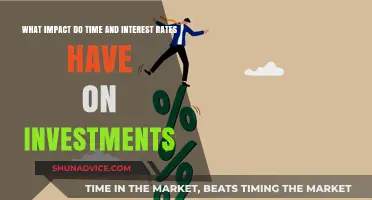
Understanding the realistic interest rates on investments is crucial for making informed financial decisions. Interest rates play a significant role in determining the profitability of investment vehicles, such as savings accounts, bonds, and fixed deposits. In this discussion, we will explore the factors that influence interest rates, the varying rates offered by different financial institutions, and how investors can assess and compare these rates to find the most suitable options for their financial goals. By the end of this exploration, readers will have a clearer understanding of what constitutes a realistic interest rate in the context of investments.
What You'll Learn
- Historical Context: Understand interest rates over time and their impact on investments
- Market Factors: Explore how economic conditions influence interest rates and investment returns
- Risk and Reward: Learn how risk levels affect interest rates and potential returns
- Government Policies: Discover how government interventions shape interest rates and investment strategies
- Investment Vehicles: Examine various investment options and their associated interest rate expectations

Historical Context: Understand interest rates over time and their impact on investments
The concept of interest rates and their influence on investments is not new; it has been a fundamental aspect of the financial world for centuries. Understanding the historical context of interest rates provides valuable insights into the current investment landscape.
In the early days of banking, interest rates were often quite high, especially during the medieval and early modern periods. Lenders demanded substantial returns due to the high-risk nature of lending money, which was often used for long-term projects or ventures. For instance, in the 14th century, interest rates could reach up to 20% or more, making investments in early banking institutions quite lucrative. However, these high rates also meant that borrowers had to pay significant sums, often leading to social and economic issues.
As time progressed, central banks and governments began to play a crucial role in setting and regulating interest rates. The 19th and 20th centuries saw a gradual shift towards more stable and controlled interest rate environments. During this period, the establishment of central banking systems and the introduction of fractional reserve banking allowed for more manageable and predictable interest rates. This era also witnessed the rise of various investment vehicles, such as bonds and stocks, which offered investors a range of options to diversify their portfolios.
The post-World War II era brought about a significant change in interest rate dynamics. With the establishment of the Bretton Woods system, interest rates were closely tied to the value of gold, ensuring a stable global financial environment. This period saw relatively low and stable interest rates, encouraging long-term investments and fostering economic growth. However, the 1970s brought a period of high inflation and rising interest rates, often referred to as the 'Great Inflation.' This era taught investors the importance of understanding the relationship between interest rates, inflation, and investment returns.
In recent decades, interest rates have experienced significant fluctuations, often influenced by global economic events and the actions of central banks. The global financial crisis of 2008 led to a period of exceptionally low interest rates, with central banks implementing quantitative easing to stimulate economies. This era highlighted the impact of monetary policy on investment decisions, as investors sought opportunities in various asset classes to generate returns. Today, investors are faced with the challenge of navigating a complex interest rate environment, where central bank policies and economic forecasts play a pivotal role in shaping investment strategies.
Understanding the historical context of interest rates is essential for investors as it provides a framework to analyze current market conditions. By studying past trends and the factors that influenced interest rates, investors can make more informed decisions. For instance, recognizing the impact of inflation on interest rates can help investors protect their portfolios during periods of economic uncertainty. Additionally, historical data allows investors to identify patterns and potential opportunities, enabling them to adapt their investment strategies accordingly.
Understanding the Frequency of Interest Compounding on Your Investments
You may want to see also

Market Factors: Explore how economic conditions influence interest rates and investment returns
Economic conditions play a pivotal role in determining interest rates and subsequently, the returns on investments. When the economy is thriving, with low unemployment and high consumer spending, central banks often raise interest rates to control inflation. This is because a strong economy can lead to higher demand for goods and services, potentially causing prices to rise. By increasing interest rates, central banks aim to cool down the economy and prevent overheating, which could otherwise lead to unsustainable inflationary pressures. As a result, investors might see lower returns on their investments, especially in fixed-income securities like bonds, as higher interest rates make these securities less attractive.
Conversely, during economic downturns or recessions, central banks typically lower interest rates to stimulate the economy. Lower interest rates can encourage borrowing and spending, helping to revive economic growth. In such periods, investors often seek higher returns to compensate for the reduced yields on government bonds. This can lead to increased demand for riskier assets, such as stocks, which may drive up their prices and offer higher potential returns. However, it's important to note that during economic downturns, the overall market environment can be volatile, and investment returns may be more unpredictable.
Inflation is another critical market factor that influences interest rates and investment returns. When inflation rises, the purchasing power of money decreases, and the real return on investments can be eroded. Central banks often respond to high inflation by raising interest rates to curb spending and borrowing. This can lead to lower returns on investments, especially in fixed-income securities, as the nominal interest rate may not keep pace with the rising inflation rate. Investors, therefore, need to consider the inflation rate when assessing the real return on their investments.
Economic policies and government interventions also significantly impact interest rates and investment returns. Fiscal and monetary policies can influence the money supply, credit availability, and overall market sentiment. For instance, quantitative easing, a monetary policy tool, involves central banks purchasing government bonds to inject liquidity into the financial system, which can drive down interest rates. This, in turn, may encourage investment and stimulate economic growth. However, such policies can also lead to asset bubbles if not carefully managed, potentially resulting in volatile investment returns.
Understanding these market factors is crucial for investors to make informed decisions. Economic conditions, inflation, and government policies collectively shape the interest rate environment and, consequently, the potential returns on investments. Investors should stay informed about economic indicators, central bank decisions, and global events that could impact interest rates and market dynamics. By considering these factors, investors can better navigate the investment landscape and make strategic choices to align their portfolios with their financial goals and risk tolerance.
Interest Rate Drop: How Investment Spending Adjusts
You may want to see also

Risk and Reward: Learn how risk levels affect interest rates and potential returns
When considering investments, understanding the relationship between risk and reward is crucial, especially when it comes to interest rates. The concept is simple: the higher the risk, the higher the potential return, and consequently, the higher the interest rate. This principle is a fundamental aspect of the financial world and is essential for investors to grasp.
Risk, in the context of investments, refers to the uncertainty and potential for loss. It encompasses various factors such as market volatility, credit risk, and liquidity risk. For instance, investing in a startup might offer high growth potential but also carries a significant risk of failure. On the other hand, government bonds are generally considered low-risk investments due to the stability and creditworthiness of the issuing government.
Interest rates, in this scenario, act as a reward for taking on risk. When an investor chooses a high-risk investment, they are essentially agreeing to potentially higher returns. This is because the higher the risk, the more attractive the prospect of a substantial profit becomes. For example, if a high-risk investment yields a 10% return, it might be more appealing to an investor compared to a low-risk option with a 2% return.
The relationship between risk and interest rates is a delicate balance. Investors must carefully assess their risk tolerance, which is the level of risk they are willing to accept. A conservative investor might prefer low-risk investments with lower returns, while a more aggressive investor could seek higher-risk options for potentially greater gains. It's about finding the right match between risk appetite and investment goals.
In summary, the interest rate on an investment is directly linked to its risk level. Higher-risk investments typically offer higher interest rates and potential returns. Investors should educate themselves about various investment options and their associated risks to make informed decisions. Understanding this dynamic is key to building a successful investment portfolio that aligns with one's financial objectives and risk tolerance.
Unleash Your Wealth: 10 Investments with 10% Compound Interest
You may want to see also

Government Policies: Discover how government interventions shape interest rates and investment strategies
Government policies play a crucial role in determining interest rates and influencing investment decisions, which in turn has a significant impact on the economy as a whole. These interventions can either directly or indirectly affect the cost of borrowing and lending, shaping the financial landscape. Here's an exploration of this relationship:
Monetary Policy and Interest Rates: One of the primary tools governments and central banks use to manage the economy is monetary policy. This policy involves adjusting interest rates, which are the cost of borrowing money. When a government decides to lower interest rates, it becomes cheaper for businesses and individuals to borrow, encouraging investment and spending. Lower rates stimulate economic activity, as more people and companies are inclined to take out loans for various purposes, such as starting new ventures, expanding existing ones, or making major purchases. Conversely, raising interest rates has the opposite effect; it becomes more expensive to borrow, potentially slowing down economic growth.
Government Spending and Fiscal Policy: Fiscal policy, which involves government spending and taxation, also has a direct impact on interest rates. Increased government spending can lead to higher demand for loans, driving up interest rates. This is because the government's borrowing needs can influence the overall borrowing costs in the market. For instance, during economic downturns, governments often implement expansionary fiscal policies by increasing spending to stimulate the economy. This increased spending can lead to higher interest rates as the government's debt levels rise. On the other hand, during prosperous times, governments might opt for contractionary fiscal policies, reducing spending to control inflation, which could result in lower interest rates.
Regulation and Investment Strategies: Government interventions in the form of regulations can significantly shape investment strategies. For example, regulations on the financial industry can influence the types of investments available to the public. Certain industries or sectors might be favored or restricted through regulatory policies, impacting the interest rates associated with specific investment vehicles. Additionally, governments can implement tax policies that encourage or discourage certain types of investments. Tax incentives or deductions for specific investment vehicles can attract more investors, potentially driving up interest rates in those markets.
Impact on Long-Term Investments: Government policies can also influence long-term investment strategies. For instance, pension funds and long-term investors often seek stable, long-term returns. Government interventions that promote economic stability and consistent growth can make such investments more attractive, potentially leading to higher interest rates in the long-term investment sector. Moreover, government guarantees or subsidies for specific industries can encourage investors to allocate more capital to those sectors, further impacting interest rates.
Understanding these government interventions is essential for investors, businesses, and policymakers alike. It highlights the intricate relationship between economic management and financial markets, demonstrating how government decisions can shape the investment landscape and, consequently, the overall economic health of a nation.
Understanding Tax Implications: Is Investment Income Taxable?
You may want to see also

Investment Vehicles: Examine various investment options and their associated interest rate expectations
When considering investment options, understanding the associated interest rates is crucial for making informed financial decisions. Here's an overview of various investment vehicles and their typical interest rate expectations:
- Savings Accounts: Traditional savings accounts offered by banks are a fundamental investment choice for many individuals. These accounts provide a relatively safe and liquid option. The interest rates on savings accounts can vary widely depending on the bank and the type of account. Typically, high-yield savings accounts offer higher interest rates compared to standard savings accounts. As of my knowledge cutoff in January 2023, the average annual percentage yield (APY) for online savings accounts in the United States ranges from 0.50% to 2.50%, while brick-and-mortar banks might offer slightly lower rates.
- Certificates of Deposit (CDs): CDs are time-bound deposits that offer higher interest rates for committing funds for a fixed period. The interest rate on CDs is directly proportional to the term length, with longer-term CDs generally providing higher returns. For instance, a 1-year CD might offer an average interest rate of around 1.50%, while a 5-year CD could yield 2.50% or more. It's important to note that early withdrawals from CDs may incur penalties, so investors should carefully consider their financial goals and the time horizon before investing.
- Bonds: Bonds are fixed-income securities that represent a loan made by an investor to a borrower (typically a government, municipality, or corporation). The interest rate on bonds is known as the coupon rate and is paid periodically (often annually or semi-annually) until maturity. Government bonds are generally considered low-risk, offering relatively stable interest rates. For instance, US Treasury bonds have historically provided interest rates ranging from 1% to 3% or more, depending on the maturity date. Corporate bonds, on the other hand, may offer higher interest rates but carry more risk.
- Stocks and Dividend-Paying Stocks: Investing in individual stocks or exchange-traded funds (ETFs) that pay dividends can provide an opportunity for both capital appreciation and regular income. The interest rate or return on stocks is not fixed but can vary significantly based on market performance and the company's profitability. Dividend-paying stocks offer a more consistent income stream, with interest rates varying depending on the company's dividend policy. For example, large-cap, blue-chip companies often provide stable dividends, while smaller-cap stocks might offer higher yields but with greater volatility.
- Peer-to-Peer Lending: P2P lending platforms enable individuals to lend money directly to borrowers, often at higher interest rates than traditional savings accounts. The interest rates on P2P loans can vary widely, depending on the borrower's creditworthiness and the platform's policies. These platforms typically offer competitive interest rates, sometimes exceeding 5% annually, but they also carry higher risks compared to more established investment vehicles.
When evaluating investment options, it's essential to consider your risk tolerance, investment horizon, and financial goals. Interest rates are just one factor to consider, as other factors like capital appreciation, liquidity, and tax implications also play a significant role in determining the overall return on your investments.
High-Interest Investing: Weighing the Risks and Rewards
You may want to see also
Frequently asked questions
The interest rate on investments can vary widely depending on various factors such as the type of investment, market conditions, and your risk tolerance. As a general rule, short-term investments like money market accounts or high-yield savings accounts typically offer lower interest rates compared to long-term investments like stocks, bonds, or real estate. It's important to research and understand the specific investment you're considering and compare it to market averages to set realistic expectations.
Calculating the expected interest rate involves assessing your entire investment portfolio. Start by identifying the average maturity or time horizon of your investments. Then, consider the historical average returns of similar investments in the past. You can also use financial models and risk assessments to estimate potential returns. Remember that past performance is not a guarantee of future results, and market conditions can fluctuate.
No, there are no guarantees when it comes to interest rates. Interest rates are influenced by market forces and can change over time. Fixed-income investments like bonds may offer a fixed interest rate, but even then, factors like credit rating, market demand, and economic conditions can impact the actual return. It's essential to stay informed and regularly review your investments to make adjustments as needed.
Estimating the realistic interest rate for your investment requires thorough research and analysis. Start by understanding the investment's risk profile and the factors that typically drive returns in that asset class. Compare similar investments in the market and consider the following: historical performance, market trends, economic indicators, and expert opinions. Additionally, consult financial advisors who can provide personalized advice based on your financial goals and risk tolerance.
One common misconception is that higher interest rates always equate to better returns. While higher rates can be attractive, they may not always be realistic or sustainable. Another myth is that all investments offer the same interest rate, which is not true due to the diverse nature of investment options. It's crucial to educate yourself, seek professional advice, and make informed decisions based on your financial objectives and risk preferences.







